What is a property management system?
Liz Pollock
14 April 2025
Your inbox isn’t a system.
A notebook isn’t a system.
That whiteboard with half-erased tasks from three weeks ago? Still not a system.
And those clunky legacy platforms you’ve been wrestling with since 2015? They might technically qualify — but they’re not helping anyone move faster.
A modern property management system is the difference between managing properties and running a business.
It brings all the moving parts — rent collection, maintenance, communication, compliance, etc — into one place, so your team can collaborate better, stay consistent, and actually breathe between tasks.
In this guide, we’ll unpack what a modern property management system does, how it’s evolved, and what to look for if you’re ready to upgrade how your agency works.
What is a modern property management system?
A modern property management system digitises and streamlines daily workflows that keep a rental portfolio running smoothly.
Instead of juggling spreadsheets, email chains, and paper files, everything lives in one centralised system. Think of it as your operational hub — where tasks, people, and payments come together.
The best systems support six core areas:
2. Workflows and tasks
3. Renter and lease management
4. Customers & communication
5. Compliance
6. KPI Reporting & data insights
And when those areas are connected? You save time, reduce errors, and create a better experience for everyone — renters, investors, and your team.
When a renter at an Ailo agency reported a broken light fitting, the property manager turned a simple request into a fully visible, end-to-end process:
- The renter submitted a message with a photo via the app
- The property manager linked the message to a maintenance project using Ailo Projects
- The system pre-populated next steps, including investor approval and trade coordination
- Investor instructions and updates were shared via chat and email, directly from the project
- Everyone involved — including other team members — could see the full conversation, photos, and progress in real-time
The result: maintenance, messaging, investor approvals, and task tracking all lived in one workflow — no switching between systems, no chasing updates
This kind of end-to-end workflow isn’t possible with disconnected software.
The core features every modern property management system should include
1. Payments and accounting
Automated rent collection is a must — but flexibility is just as important.
With Ailo, investors can choose when and how they’re paid, renters receive reminders automatically, and your team doesn’t have to chase payments or generate manual reports.
Everything updates in real time, with full visibility across your portfolio.
And because Ailo is built for property management — not generic accounting — trust compliance is baked in from day one.
2. Workflows and tasks
To-do lists are only helpful if you can act on them. A modern system should let you do the work inside the workflow.
With Ailo Projects, your team can message a renter, update an investor, upload a photo, trigger a form, or complete a task — all from the same screen. No tab jumping.
No second systems. Just clear steps, shared visibility, and smart automation to save your team time (including embedded AI-powered features where it counts).
3. Renter and lease management
Managing renters shouldn’t mean juggling tabs and calendars. A modern system helps you track lease agreements, renewal dates, rent increases, and bond workflows — all in one place.
4. Customers & communication
Communication is half the job — and your platform should treat it that way.
Ailo brings together chat, email, and project updates in one place, so your team stays on top of conversations and nothing falls through the cracks.
Renters can request maintenance, make payments, and communicate directly with your team from their app.
Investors can view inspection reports, rent payments, and receive updates without needing to call. That’s fewer follow-ups for your team — and better service for your clients.
5. Compliance
Look for a platform that keeps you compliant by design — not by workaround.
Ailo helps agencies manage both trust accounting and property compliance with less effort and risk.
Whether it’s smoke alarms or entry notices, Ailo’s Projects can guide your team through the correct steps and keep a full audit trail — and everything stays visible, searchable, and up to date across your team.
6. KPI reporting and data insights
Modern platforms don’t just track your rent roll — they help you grow it.
Look for systems that surface the right metrics at the right time, like arrears, vacancy rates, task completion, and team performance. Ailo gives you real-time visibility across your portfolio, so you can see what’s working, spot issues early, and make confident decisions.
Whether you're managing risk, setting goals, or coaching your team — your data should guide you.
Traditional vs modern property management systems
The limitations of legacy systems
Older property management software features clunky interfaces requiring extensive training, limited mobile functionality, and data trapped in silos that don't communicate. What modern cloud-based systems offer
Modern, cloud-based systems like Ailo are fast, flexible, and designed with property managers in mind. They offer:
- 24/7 access from anywhere
- Intuitive interfaces and guided workflows
- Purpose-built functionality for the Australian market — from compliance to communication
No third-party plugins or additional logins required. Everything’s in one system, so your team can work faster, smarter, and with less duplication.
How everyone wins with a modern property management system
For property managers
The right system transforms daily operations from reactive firefighting to proactive management. Features like Ailo Projects help build structured workflows for maintenance schedules, lease renewals, and compliance tasks.
Marie O'Flaherty at Ray White Upper Coomera experienced this transformation firsthand. Managing about 120 properties and working five days a week, after six weeks using Ailo, she had so much more capacity that she dropped to four days a week and has since taken on more properties.
For investors
They get real-time access to financials, statements, and property activity. No more chasing updates. Ailo also gives investors control over how and when they’re paid — weekly, monthly, or even daily.
For renters
Clearer communication, faster maintenance, and easier payments. Renters can submit issues with photos, track progress, and get real-time updates — all in one app.
Getting started with a modern property management system
Choosing the right platform isn’t just about features. It’s about finding a partner that understands the pressures of modern property management — and helps you grow. Agencies that thrive today are using technology to scale their service without sacrificing quality.
Ailo was built for that exact purpose.
Frequently Asked Questions
What makes a modern property management system different from traditional software?
Legacy systems were built for accounting — not for the way property managers actually work. A modern platform like Ailo connects communication, payments, maintenance, and workflows in one place. That means fewer tools, fewer errors, and more time for the work that matters.
How long does it take to migrate from a legacy property management system to a new one?
For the Ailo platform, migration timelines typically range from 2-6 weeks depending on your portfolio size and data complexity. Ailo offers hands-on support to manage data transfers, document imports, and team training.
Will my team need training to use a new system?
Yes — but it’s designed to be intuitive in Ailo. Ailo includes step-by-step onboarding, live training, and a dedicated support team. Most agencies find their team adapts quickly — and loves not being tied to inboxes, spreadsheets, or clunky workarounds.
What happens to my data if I need to switch property management systems later?
Reputable systems offer export tools and migration support. Always check data portability policies before committing to a platform.

